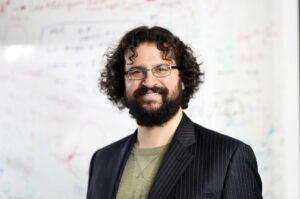Precisely how genomes ranging from a few million to billion base-pairs, several meters long, can fold into minuscule cellular nuclei, on average 6 microns in size, is a baffling conundrum. Yet, chromosome-level nuclear architecture, though poorly understood can play a crucial role in regulating gene expression in health and disease.
A new collaborative study investigates the principles of genome folding across the eukaryotic tree of life including 24 species, representing all taxonomic groups in chrordates and existing vertebrates that include animals, fungi and plants. The researchers perform a method called in situ Hi-C that detects and quantifies pairwise interactions between chromosome regions in a genome and digital simulations.
Their findings show two types or states of three-dimensional genome architectures at the chromosome scale that appear and disappear repeatedly during the evolution of nucleated organisms (eukaryotes) and is regulated by the presence of the protein, condensin II.
Between cell divisions when the cell is in interphase, the authors show, telomeres (repetitive sequences at the ends of linear chromosomes) and centromeres (specialized DNA sequences that links pairs of duplicated chromosomes, called chromatids) either cluster across chromosomes, much like the center and edges of a newspaper, or orient to maintain distinct chromosomal territories much like individual grapes in a bunch.
The authors also show removing condensin II converts the 3D nuclear architecture of human genomes to that resembling mosquito.
The study, which appears in the journal Science in an article titled “3D genomics across the tree of life reveals condensin II as a determinant of architecture type” emerged from collaborative efforts of DNA Zoo, an international consortium spanning dozens of institutions including Baylor College of Medicine, the National Science Foundation (NSF) supported Center for Theoretical Biological Physics (CTBP) at Rice University, the University of Western Australia and SeaWorld.

“Whether we were looking at worms or urchins, sea squirts or coral, we kept seeing the same folding patterns coming up,” says Olga Dudchenko, PhD, co-first author of the new study and a member of the Center for Genome Architecture at Baylor and CTBP.
The team eventually zeroed in on two overall nuclear architectures from this multi-species analysis.
“In some species, chromosomes are organized like the pages of a printed newspaper, with the outer margins on one side and the folded middle at the other,” explained Dudchenko, who also is co-director of DNA Zoo. “In other species, each chromosome is crumpled into a little ball.”

“We had a puzzle,” says Erez Lieberman Aiden, PhD, an associate professor of molecular and human genetics, Emeritus McNair Scholar at Baylor, co-director at DNA Zoo, director of the Center for Genome Architecture, a senior investigator at CTBP and senior author on the new study.
“The data implied that over the course of evolution, species can switch back and forth from one type to the other. We wondered: What is the controlling mechanism? Might it be possible to change one type of nucleus into another in the lab?” says Aiden.
Meanwhile, an independent team in the Netherlands was working on the role of condensin II in cell division.
“When we mutated the protein in human cells, the chromosomes would totally rearrange. It was baffling!” says Claire Hoencamp, PhD, co-first author on the study and a member of the laboratory of Benjamin Rowland, PhD, at the Netherlands Cancer Institute.

The Rowland and Aiden teams met at a conference in the Austrian mountains where Rowland presented his lab’s latest work. Combining their data, the teams inferred Hoencamp had converted human cells from one nuclear state to another by mutating condensin II.
“When we looked at the genomes being studied at the DNA Zoo, we discovered that evolution had already done our experiment many, many times! When mutations in a species break condensin II, they usually flip the whole architecture of the nucleus,” said Rowland, senior author on the study. “It’s always a little disappointing to get scooped on an experiment, but evolution had a very long head start.”

The team decided to work together to confirm condensin II’s role but the COVID-19 pandemic struck.
“Without access to our laboratories, we were left with only one way to establish what condensin II was doing,” says Hoencamp. “We needed to create a computer program that could simulate the effects of condensin II on the chain of hundreds of millions of genetic letters that comprise each human chromosome.”

To accomplish this, the team turned to José Onuchic, PhD, the Harry C. and Olga K. Wiess Chair of Physics at Rice.
“Our simulations showed that by destroying condensin II, you could make a human nucleus reorganize to resemble a fly nucleus,” says Onuchic, co-director of CTBP, which includes collaborators at Rice, Baylor, Northeastern University and other institutions in Houston and Boston.
Sumitabha Brahmachari, PhD, postdoctoral fellow and co-first author Onuchic’s lab at CTBP, working with Vinicius Contessoto, PhD, a former postdoc at CTBP, and Michele Di Pierro, PhD, a CTBP senior investigator and currently an assistant professor at Northeastern University, performed the simulations.
Brahmachari says, “We began with an incredibly broad survey of 2 billion years of nuclear evolution and we found that so much boils down to one simple mechanism, that we can simulate as well as recapitulate, on our own, in a test tube. It’s an exciting step on the road to a new kind of genome engineering—in 3D!”



